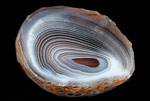Agate - Mineral & Healing Properties

Chemistry: SiO2
Class: tectosilicate
Subclass: Tectosilicates
Uses: Uses for agates are to make ornaments such as pins, brooches, paper knives, inkstands, marbles and seals.
CLICK HERE To Purchase Kidz Rocks Agate Products.
-
 Red Agate
Red Agate -
 Dendrite Agate
Dendrite Agate -
 Crazy Lace Agate
Crazy Lace Agate -
 Fortification Agate
Fortification Agate
Agate is the most creative stone made by "Mother Nature". Agate is chalcedony formed from layers of quartz. Chalcedony is a form of Silica and it is composed of very fine uneven splintery mineral quartz. Although agates may be found in various kinds of rock, they are associated with volcanic rocks and can be common in certain metamorphic rocks.
As a general term, agate is so broadly descriptive that there are hundreds of names applied to varieties of agate from different localities. While many names reflect the source, some popular varieties are descriptive, such as "blue lace agate".
Note that in come cases, the term "agate" is used where the term "jasper" may be more accurate, as in "moss agate" in which a white quartz contains a fractal pattern of green and black, resembling tiny blades of moss.
Agate is primarily formed by the deposit of silica from solution. It is also a common method of fossilization, as the organic remains of some living thing are gradually replaced by quartz. "Agatized coral" from the Tampa Bay area is an excellent example, as are all of the specimens of petrified wood.

Origin Of The Name
The stone was given its name by Theophrastus, a Greek philosopher and naturalist, who discovered the stone along the shoreline of the river Achates sometime between the 4th and 3rd centuries BC.

Interesting Facts
Agate is one of the most common materials used in the art of hardstone carving, and has been recovered at a number of ancient sites, indicating its widespread use in the ancient world.
There are many forms of Agate and they are: Madagascar Agate, Asia Agate, Moss Agate, India Black Skin Agate, Plume Agate, Blue Lace Agate, Banded Agate, Montana Agate, Red Agate, Fire Agate, Crazy Lace Agate, Argentina Agate, Dry Head Agate, Mexican Lace Agate, Laguna Agate, Banded Agate, Graveyard Agate, Botswana & Tree Agate. Natural Agate color is clear or milky white, gray, blue, green, pink, brown and it is often artificially colored.

Where Is It Found
It is a mineral generally of secondary origin, forming in cavities and veins by deposition from meteoric groundwater containing gelatinous silica from the weathering of silicate minerals. It can also form by deposition from late hydrothermal solutions at or near the earth's surface under conditions of low temperature and low pressure. Agate is commonly associated with siliceous volcanics, occurring as vein or vesicle filling. It occurs as a petrifying agent in fossil wood and bone. Agate is frequently found lining or filling rock cavities and fissures, sometimes forming geodes.
Country's of origin for the Agates are: USA, India, Morocco, Czech Republic, Brazil & Africa.

What Do We Do With It
Uses for agates are to make ornaments such as pins, brooches, paper knives, inkstands, marbles and seals. Because of its hardness and ability to resist acids, agate is used to make mortars and pestles to crush and mix chemicals.
In medieval times, the wearing of agate was said to bring God's favor and make one agreeable and persuasive, giving victory and strength to the wearer and protection from all dangers. Wearing agate was also thought to give pleasant dreams and cure insomnia. Early Greeks made amulets of agate for protection from the elements of the sea.
Some of the earliest primitive stone tools (axes) fashioned by man's ancestors 2.5 million years ago in the Omo valley in Ethiopia, were made of quartz varieties such as agate. These materials were used because of their hardness and their isotropic brittleness which made it possible to shape the tools with relative ease.

Metaphysical Uses
Agate's most noticeable properties overall are balancing yin/yang energy, courage, protection, healing, and calming. Historically it was placed in water for cooking or drinking to dispel sickness. The Metaphysical and Healing Properties Lore of any specific type of agate depend to some extent on the color of the agate, but all agates have certain things in common.
Agate is a stone of strength. It was used by the Ancients on the breastplates of armor to give warriors strength and make them victorious in battle. Energetically, it is considered to give strength in both battle and physically.
Agate enhances creativity and strengthens the intellect, making it a beneficial stone for both students and artists. It is also known as a good luck stone. As a stone of harmony, one of the things agate does is balance yin/yang energy. Agate increases energy. However, because it is a grounding stone, it does not increase energy at all times, but rather enables bursts of energy as needed. In this way, agate is a conservation stone, and enhances longevity.
Agate is a very protective stone. It is especially protective for children, and makes an excellent stone for children's amulets, medicine bags, jewelry, or just to carry around in a pocket.
Emotionally, agate gives courage, emotional strength, self-confidence, and dispels fears. It can also lessen feelings of envy by grounding the emotions. In the same way, it assists with acceptance of all things.

Physical Characteristics
Color: Nearly any color, even colorless.
Luster: Dull vitreous to greasy.
Transparency: translucent, can be transparent or opaque.
Crystal System: Hexagonal-R; 32 (trigonal-trapezohedral)
Crystal Habits: usually as banded or layered botryoidal masses with microfibrous structure.
Cleavage: Cryptocrystalline quartz shows no cleavage, although parting may occur along layers and splintery fracture can develop parallel to microfibrous orientation.
Fracture: Conchoidal to splintery
Hardness: 7
Specific Gravity: 2.57-2.64
Streak: White
Associated Minerals: Agate is commonly associated with siliceous volcanics.

Educational Videos
Patagonia Agates, Argentina



